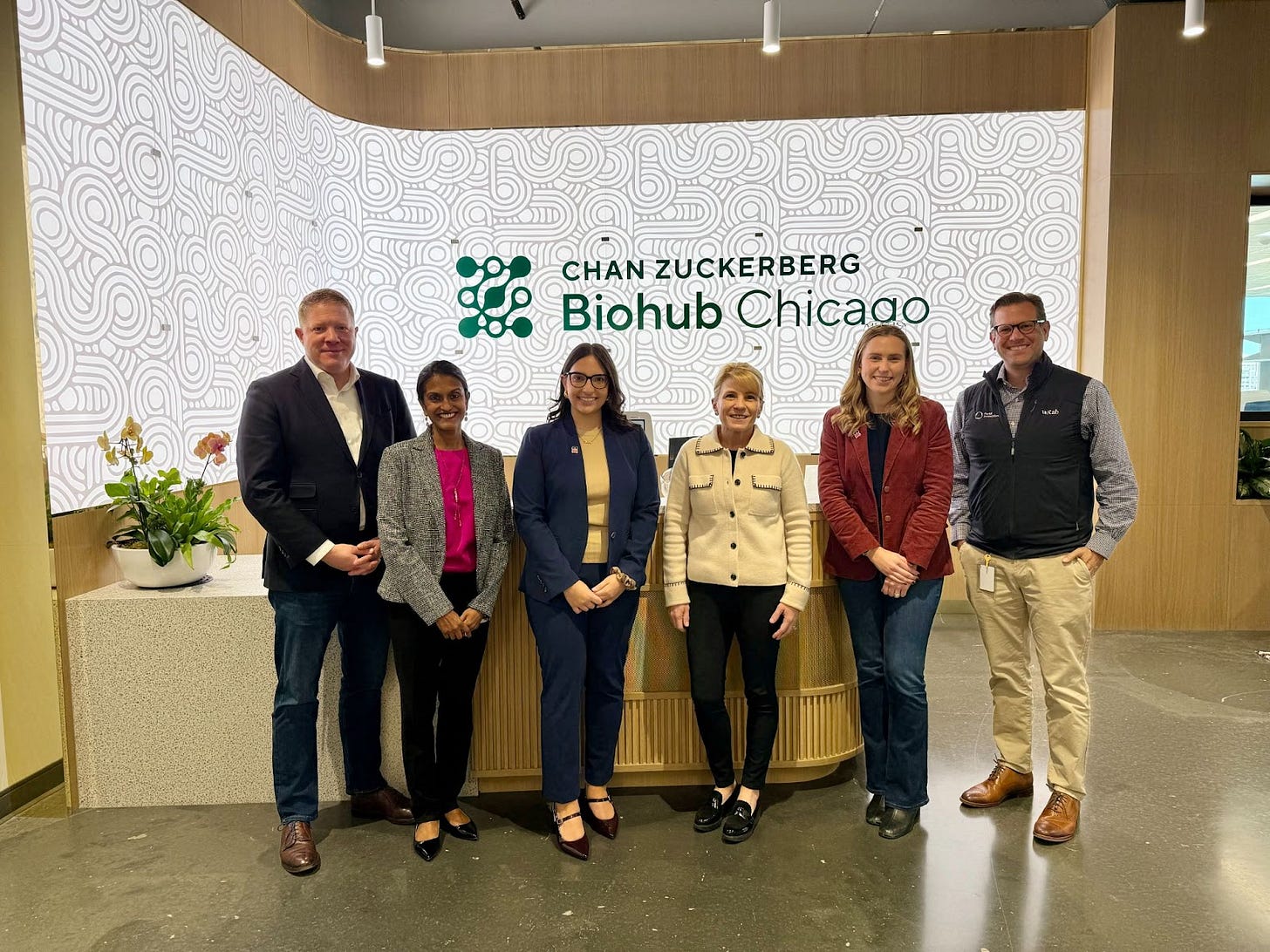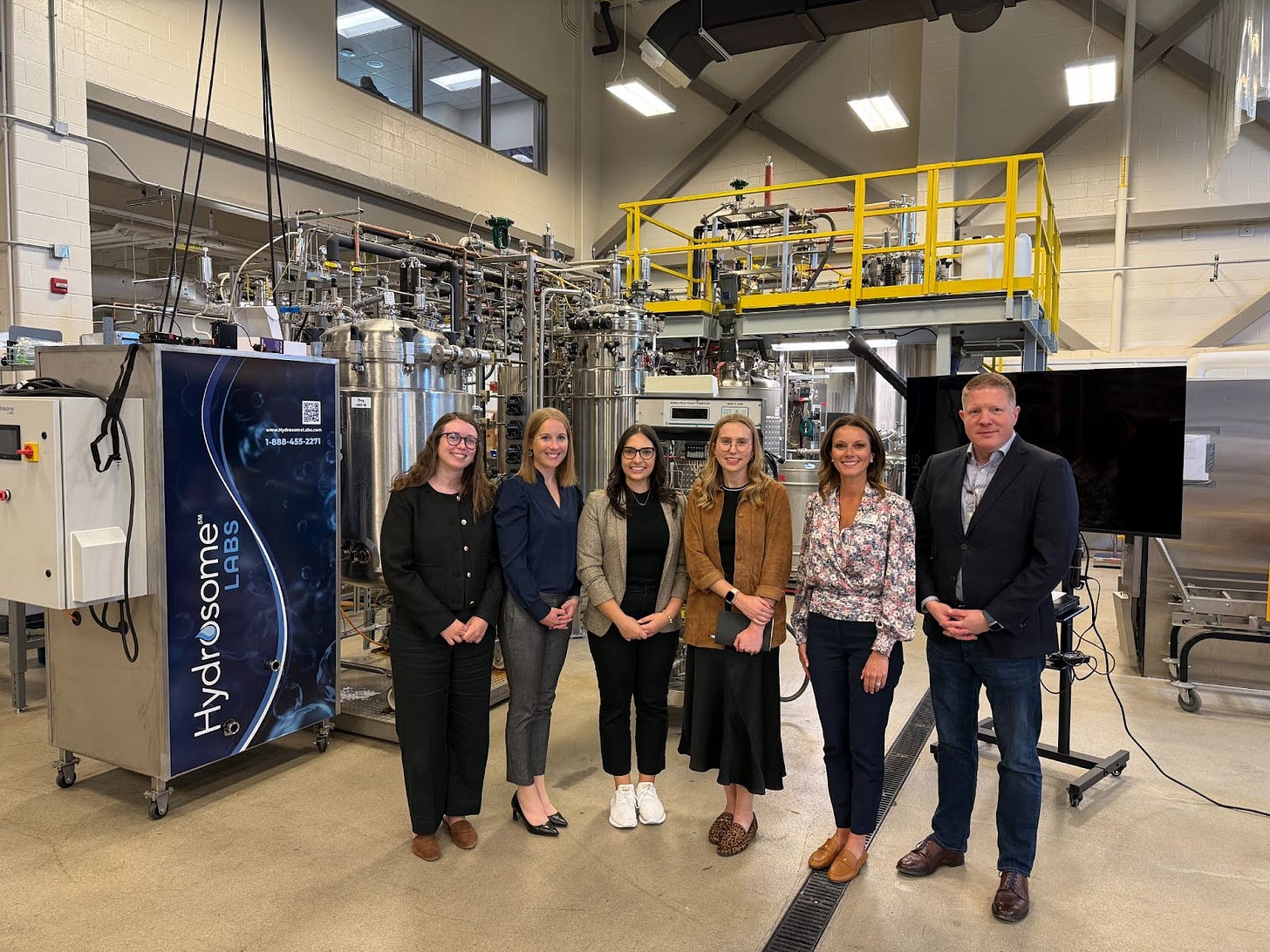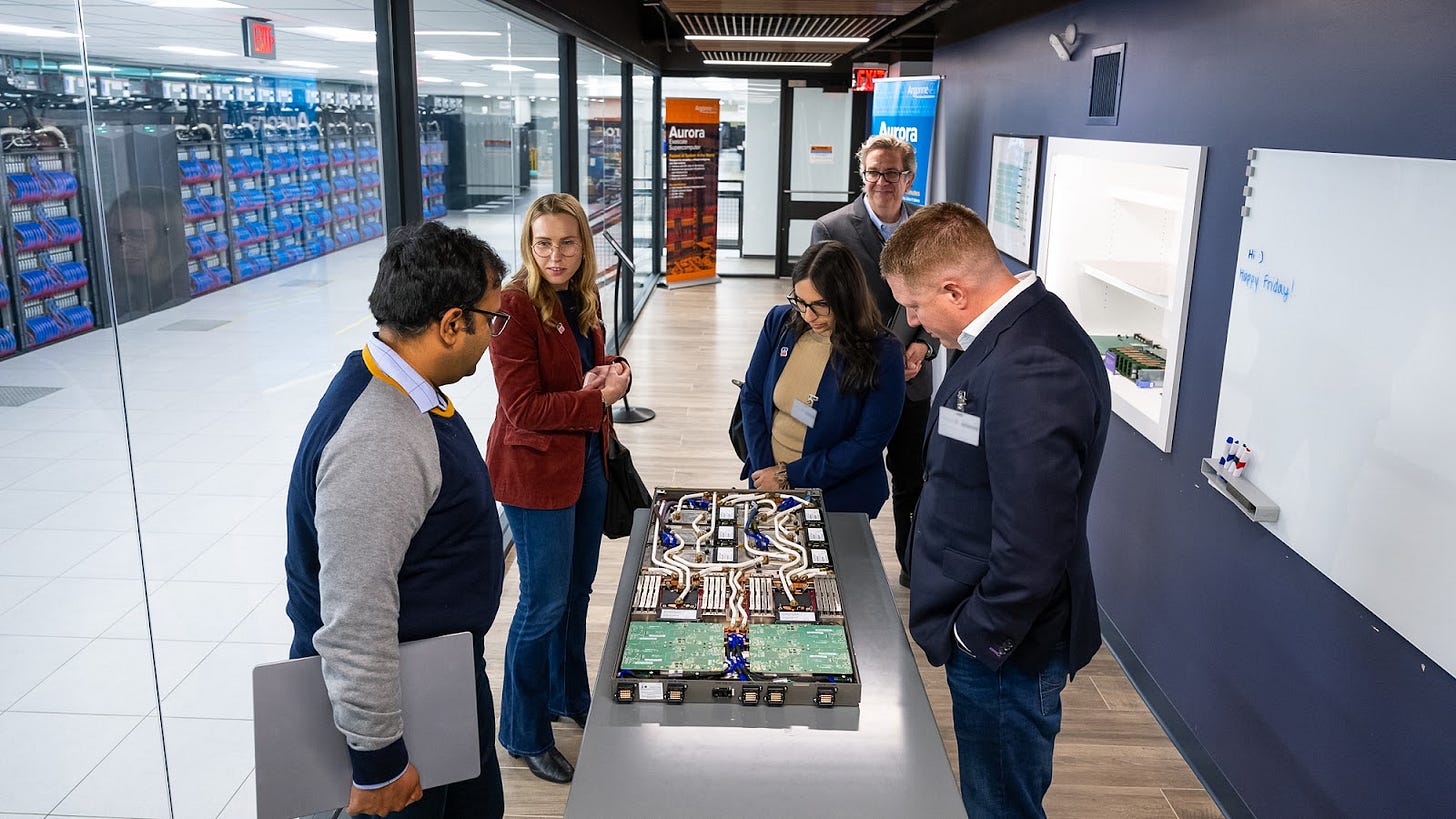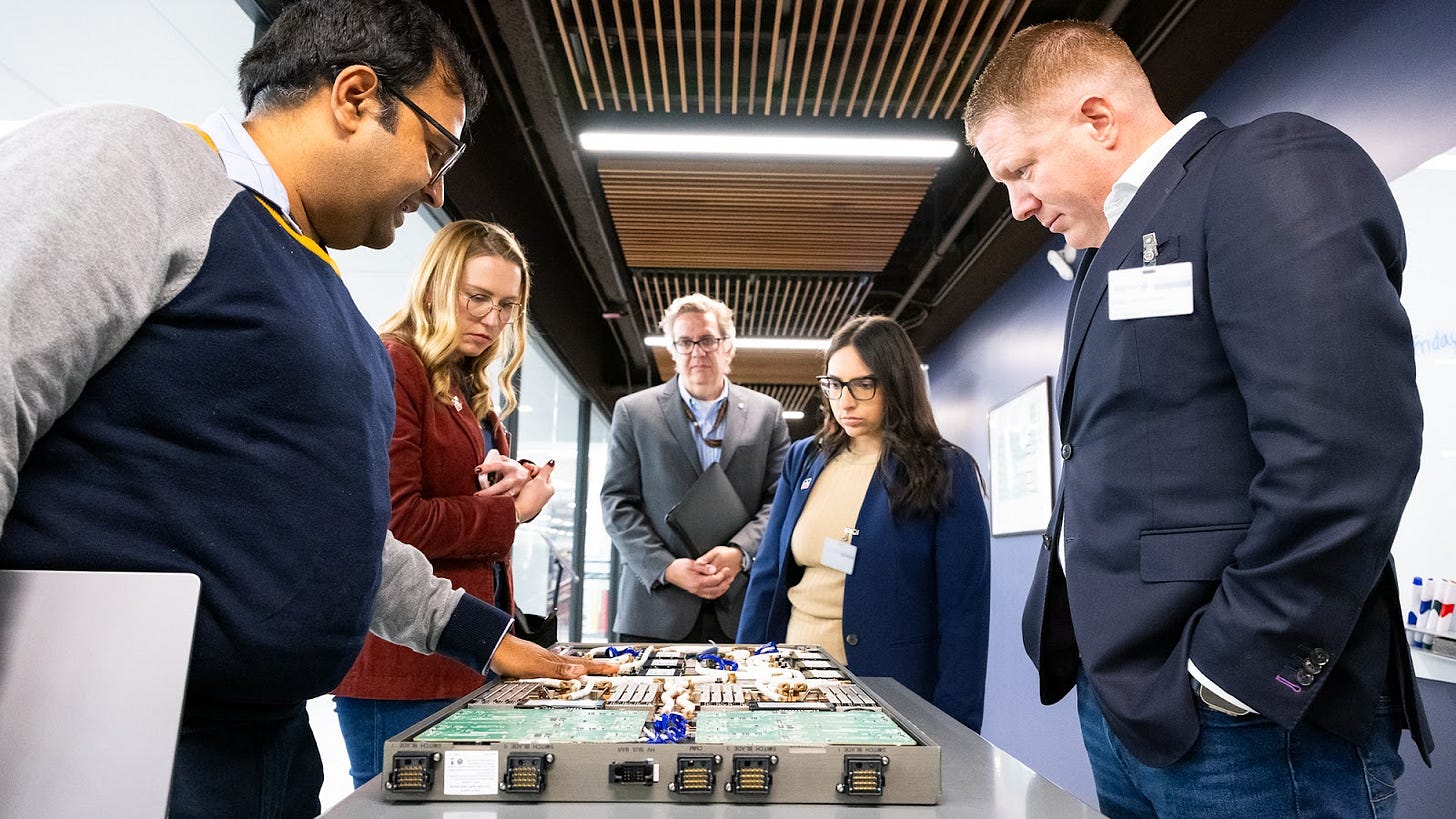Hello, I’m Ylli Bajraktari, CEO of the Special Competitive Studies Project. In this edition of our newsletter, SCSP’s Karina Barao and Abigail Kukura reflect on their recent trip with SCSP Advisor Michael Kuiken to Illinois to explore how the region’s biomanufacturing ecosystem is taking shape.
📖 Genesis: Artificial Intelligence, Hope, and the Human Spirit
A special thank you to those who have participated and shared our newsletter last week. We are encouraged to see the excitement around Dr. Eric Schmidt’s newest release on AI with Craig Mundie and the late Dr. Henry Kissinger. We’d like to continue to share this useful resource with our readers!
If you share our newsletter with your network using the link below and a new subscriber joins us, you will receive a copy of the book while supplies last.
On the Road to Biomanufacturing
Setting the Stage: Recent Policy Moves in Biotechnology
Next to the corn and soy fields of central Illinois, the future of manufacturing is brewing in fermentation tanks. Biomanufacturing represents a $200 billion opportunity to change how we build everything from food to chemicals to construction materials to medicines. At the heart of biomanufacturing is precision fermentation – a process that turns biological products like soy and corn into building blocks for manufacturing.
As SCSP wrote in our National Action Plan for U.S. Leadership in Biotechnology, biotechnology is a massive general-purpose technology that spans various sectors, from health and agriculture to defense and manufacturing. And as noted in SCSP’s National Action Plan for U.S. Leadership in Advanced Manufacturing, biomanufacturing is one of the most promising opportunities to revitalize America’s manufacturing prowess. In early October, we embarked on a trip to see what the biomanufacturing revolution looks like on the ground. Our destination: Illinois, a growing hub poised to become the ground floor for a thriving U.S. biomanufacturing ecosystem.
Our trip took us through a dynamic ecosystem where diverse actors are leveraging a range of techniques to push the boundaries of biology. From high-impact philanthropy in Chicago’s historic meatpacking district, to the sprawling campus of Argonne National Lab a short drive south, to the buzzing innovation hub growing around the University of Illinois in Urbana-Champaign (UIUC), we saw firsthand how public-private partnerships are advancing this general purpose technology and charting the future towards U.S. biotechnology leadership.
In Illinois, the biomanufacturing revolution is gaining momentum. The state is leveraging its key ingredients: a vast supply of soybeans and corn, existing bioprocessing infrastructure and world-renowned labs, and decades of science and technology expertise to turn its competitive advantages into a strategic plan to be a global hub for biomanufacturing. This shift is a new strategic view, one that identifies opportunities to repurpose existing capabilities and infrastructure for emerging bioapplications.
The sites we visited illustrate how different actors play unique and complementary roles in advancing biotechnology innovation.
Strategic Actors Fermenting the Next Generation of Biotechnology
Philanthropy
One of our first stops was Biohub Chicago, a non-profit research institute part of a larger Biohub Network supported by the Chan Zuckerberg Initiative (CZI). With the power of private sector-scale AI and vast datasets behind them, Biohub Chicago and the other research institutes within the Biohub Network operate with the agility of industry and national lab-sized budgets to focus on transformative areas in the public interest. This high-risk, high-reward research, combined with early-stage commercialization of breakthrough tools and platforms, is helping activate life science ecosystems in Chicago and across the nation. Philanthropic actors, like CZI, often fill the gap in research and development between government research programs and industry commercial production. They can play a key role in developing foundational tools and data sets in AI-driven scientific discovery that complement the work of government agencies like NIH, ARPA-H, and DoD. Philanthropy actors could also be key players in identifying and executing bold technology ambitions or “moonshots” in public-private partnerships with government actors.

U.S. Government National Labs
Argonne National Lab (ANL) is home to the Argonne Leadership Computing Facility (ALCF), where the world’s 2nd fastest exascale computer, AURORA, is beginning to roar to life. ANL also houses the infrastructure for the world’s brightest X-Ray, the Advanced Photon Source (APS). Together, these user facilities bring thousands of researchers to the campus to leverage ANL’s infrastructure for materials discovery, AI-based modeling, and autonomous experimentation in a wide range of fields. ANL is also partnering with industry players to integrate AI accelerator hardware into its supercomputer systems, creating a platform to combine cutting-edge AI hardware with the data, computational infrastructure, and tools housed at U.S. national labs.
These hardware capabilities may contain the secret sauce for AI-enabled biotechnology, generating vast amounts of scientific data that can be harnessed for a wide range of bioapplications. If gathered and made available to the private sector, national lab data could have a “flywheel” effect that helps the overall biomanufacturing ecosystem model, predict, and optimize their systems for scale. The combined power of the U.S. private sector and the national labs’ world-class infrastructure, cross-disciplinary scientific expertise, and decades of experimental data amounts to a national treasure that should be harvested for national advantage.
ANL’s Chain Reactions Program equips startups with financial support, expertise, and advanced research spaces to accelerate the journey from lab to market. Eat Meati is a company from the program's first cohort and is harnessing mycelium, one of nature’s powerful energy sources, to create innovative, mycelium-based foods. Meati exemplifies how the cutting-edge capabilities national labs provide can spark unexpected breakthroughs, taking scientific discoveries from the labs to grocery store aisles.
Universities
In the heart of Illinois is a 51-mile radius that will contain an end-to-end ecosystem for biomanufacturing. The Integrated Bioprocessing Research Laboratory (IBRL) at the University of Illinois Urbana-Champaign is the central locus of activity for the Illinois Fermentation and Agriculture Biomanufacturing (iFAB) Tech Hub. Recognized and boosted by the EDA’s tech hub program, this ecosystem of startups, university researchers, and large-scale food and agriculture industry players has, since 2018, been moving bioproducts from basic discovery to pilot-scale production and commercialization. The goal is to leverage America’s local resources, such as Illinois’ supply of soybeans and corn, to drive national impacts, including the development of next-generation biofuels.
iFAB represents a public-private model being cultivated on university grounds, featuring several key elements: 1) Developed around a world-class university research facility; 2) natural abundance of critical inputs for fermentation in soy and corn; 3) industry partners willing to help new entrants achieve commercial scale; and 4) a mosaic of local, regional, and national investment programs to tap into.
Adapting lessons from the biopharma sector could help supercharge this promising model. European governments have strategically incentivized biopharmaceutical companies to retrofit bioprocessing infrastructure for food and agriculture applications. Although biopharma and food/agriculture sectors operate with distinct incentive structures – biopharmaceutical products are typically low yield and high value while food/agriculture products tend to be high yield and low value – the infrastructure building blocks are the same, offering a strong basis for growth in emerging bioapplications.
Facilities like IBRL at the UIUC are essential, offering a collaborative space for public-private partnerships to unfold where stakeholders can share resources, expertise, and equipment. This model has proven so successful that plans for an IBRL 2.0 are already underway.
While the Tech Hubs program is making strides, the program is falling short of spending all of its authorized levels. This could limit its potential to drive innovation, embed U.S. values in development, and influence the future trajectory of American progress in critical technology areas like biomanufacturing. The success of capital vehicles for biomanufacturing will come down to continuity of investment, enforcement, and the incentive design of each program.

Challenges on the Road Ahead
As biomanufacturing scales, it introduces critical supply chain, data security, and investment challenges for the United States and its allies. Transitioning to biological alternatives over petroleum-based processes increases demand for bioprocessing resources, which could strain supply chains if U.S.-based manufacturers don’t expand to meet demand. Heavy reliance on China for bioprocessing components, including fermentation tanks, grants Beijing strategic leverage. This dependence not only risks domestic biotech supply chain bottlenecks but also raises data security concerns when equipment is connected to the cloud, and critical infrastructure remains vulnerable to foreign influence. U.S. Government capital vehicles for biomanufacturing are having a positive impact, but work remains to establish a lasting impact.
Conclusion
The trip underscored how philanthropic efforts, national labs, and universities are each playing distinct yet complementary roles in advancing U.S. biomanufacturing. To maintain our leadership in biotech, it's crucial that we identify and elevate regions that contain the essential ingredients for a thriving ecosystem in the technologies that will define the 21st century.
If Illinois can harness the ambitious, moonshot mindsets and data-driven approaches of philanthropy, the rich institutional history and decades of science and infrastructure from its national labs and universities, and the strong model for scaling biomanufacturing in partnership with industry – the emergent ecosystem could drive as much as 20 percent of a $200B global market, benefiting not just the region but the nation as a whole.
What's next for biotechnology? Stay tuned for more SCSP updates as we continue to explore the road to U.S. leadership.









Hello Ylli,
Thank you for your work in organizing this space centered around Ai.
Definitely would love to talk more if able. I teach for DCPS in Washington, DC.
Thank you, in advance, for a copy of "Genesis: Artificial Intelligence, Hope, and the Human Spirit" if copies still remain. There is much to be still learned about Ai and the fine arts, such as Music. Cheers to your hard work and perseverance! Blessings, Dr. Roche